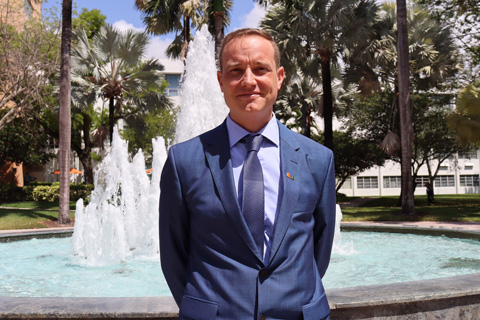While some refer to a devastating crash of crypto currencies and an industry in freefall, University of Miami business technology thought-leaders categorize the current upheaval as a shakeout, a scenario to be expected for a new and evolving technology and one that will ultimately sanitize and empower the industry.
“This shakeout points to the fact that we can now see that some business models and projects some companies are funding do not work, and that’s good for crypto—and in the long run an important sanitation of the industry,” said Ola Henfridsson, Schein Family Endowed Chair and professor of business technology at the University of Miami Patti and Allan Herbert Business School.
He noted the general trend for people to overestimate what technology can do in the short term and underestimate what it can do in the long term.

“That’s very much the case here,” Henfridsson added. “Because it’s a new technology, many new business models have not been tested.”
The same factors driving the global downturn—inflation, rising interest rates, the war in Ukraine, and global uncertainty—have prompted the crypto downturn. Some media reports even point to a perfect storm that has prompted crypto’s slide. During the pandemic people with extra funds flooded into virtual currencies, big banks and hedge funds invested, and now both have pulled away.
Robert Gregory, an associate professor at the business school, noted that one of the biggest takeaways and insights of 2022 is how the crypto markets have aligned to the general macro environment.
“These ups and downs are very normal, but one thing that’s new and that we’ve realized is the strong correlation between the crypto markets and the broader markets, possibly a sign that there is a very significant involvement of institutional players which wasn’t the case five years ago,” he said.
Henfridsson identified some of the many stakeholders that comprise “crypto space”—custodians, exchanges, traders that include hedge funds, among others—and said that the potential business or case uses of the industry are so vast that it’s difficult to speak of the industry as a cohesive whole. He emphasized the role that custodians, a third-party entrusted to store and safeguard the currency, play.
“If crypto is to become a technology or currency that’s widely adopted in society, we need to have custodial solutions. And those custodians need to be regulated in a similar way as banks,” Henfridsson said. “Some more conservative exchanges, such as Coinbase, do have collaborations with banks.”
For Henfridsson, one of the benefits of blockchain technology is its high security and capacity to resist tampering.
“No one can take your bitcoin, no one can take your wealth, and this is very valuable. But it also means that you need to have custodial solutions that make it easy for people to hold assets because otherwise you need to know cryptography [for self-custody],” he said.

While it is by nature and design decentralized, the crypto industry is looking to a government or centralized international body to provide the regulatory framework that will protect investors, according to both experts.
“This new technology has met with a regulatory void—the regulators don’t know how to classify it and it’s creating a lot of confusion because you can’t apply old ways of thinking and standards onto a new technology,” said Gregory. He pointed out that in a similar way in which the U.S. telecommunications policies of the 1990s paved the way for companies to leverage the new emerging internet platforms of that time, U.S. regulators will play an immense role in the industry’s future.
Gregory noted that while the internet evolved to become controlled by a few mega companies, the current crypto phase is in part an attempt to return to a collectively owned vision that eliminates intermediaries to deliver more equitable wealth distribution.
He differentiated between crypto believers of the original mission and short-term speculators seeking to make money from the volatility of the platform and likened the current crypto stage to the Renaissance of the 14th-17th century—an era where the advent of the printing press and the concept of double-entry booking revolutionized the world in terms of communication and business.
Henfridsson said that he sees the crypto industry playing an important role going forward, especially in a world that seems increasingly vulnerable to crises.
“We need to get used to the fact that disasters happen and to be in crisis mode,” he said. “We are currently deglobalizing—global economies are threatened because of security concerns and supply chain problems, and so we need to produce our own food and have our energy for this new type of world.”
There will be only a handful of fiat currencies that can survive this evolvement, Henfridsson suggested. And while the U.S. dollar has long been the world’s currency standard, the rise of China and the recent isolation of Russia through sanctions because of its invasion of Ukraine, have prompted both countries to seek to develop their own monetary systems, he said.
Bitcoin, because it is country and politically neutral, may well become a strong actor in the global economy, the specialist indicated.
“There is no one controlling bitcoin, no Russia, no China, no U.S., which makes it a very good alternative for smaller countries to be able to adopt something that’s legal tender,” Henfridsson explained. “That’s a powerful thing. In the next 10 years we will see more digital currencies in general and then it’s more a question of how the traditional institutions like central banks and the International Monetary Fund will shape this new technology.”
Gregory suggested that the next 12 to 18 months will bring clarity to the industry in terms of the U.S. regulatory framework.
And Henfridsson predicts a bull market when this regulation occurs.
“Many investors have been waiting on the sidelines because crypto space has not been regulated,” he said. “Once it becomes legit from their perspective, this will be massive for the entire space.”

